Choosing a Sandblaster Abrasive for Kilnforming
Silicon Carbide vs. Aluminum Oxide Firepolish Comparison Test
Micrographs by Nikki O'Neill
Samples by Tony Smith and Steve Immerman
| The purpose of this page is to demonstrate some of the functional differences between the two common sandblaster abrasives. The conclusion of this series of observations is that if you plan to blast and then refire glass, that Alumimum Oxide is a preferable abrasive. It results in a surface that is quite similar to virgin glass.
Silicon Carbide is a more agressive abrasive, and works well for deep blasting. But, when glass blasted with SiC is refired - it traps microscopic bubbles below the surface - resulting in a hazy appearance. |
|||
Image 1 |
This is a sample of Bullseye clear glass. The left half has not been blasted, the right half has been blasted with 120 grit Silicon Carbide by Tony Smith and then firepolished .
I believe that this demonstrates that a glass surface that is blasted with silicon carbide and firepolished, although acceptable to the naked eye, may not end up the same as a "virgin" surface. |
 |
SiC |
Image 1Close-up |
Close up of photo above |
 |
SiC |
Image 2 |
This sample was Bullseye black, blasted with 120 grit aluminum oxide, 20 psi. Firepolished to 1450 degrees. (White circles are frit place on the surface as identification markers.)
Nikki's observations: "There wasn't much to see. Very few nicks and small fractures." |
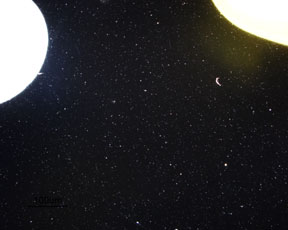 |
AlOx |
| Image 3 | Bullseye clear and black (non iridized) blasted with 200 grit silicon carbide, and fired with the blasted sides facing one another. This micrograph is focused in between the layers. |
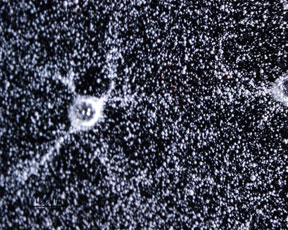 |
SiC |
| Image 3
Close-up |
Close up of image 3. |
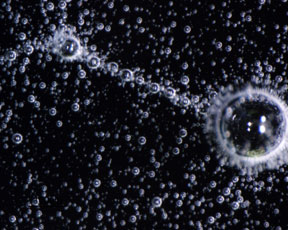 |
SiC |
| Image 4 | This sample has Bullseye iridized clear and iridized black. There is a design sandblasted with 220 grit Silicon carbide on each irid surface and they were fired to 1490 degrees, with the irid sided facing. (The yellow frit was placed on this sample to help distinguish it from the others.)
Nikki notes: "Bubbles are trapped on all layers, and fewer are evident where only one layer was blasted." |
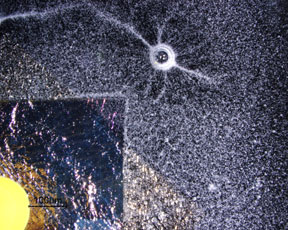 |
SiC |
| Image 4
Close-up |
Same sample as image 4. This is a view of the corner, where both top and bottom surfaces were blasted toward the top and right. Only one surface blasted bottom and left.. |
 |
SiC |
| Image 5 | Blasted with Silicon carbide. Not firepolished. |
 |
SiC |
| Image 6 | Blasted with aluminum oxide. Not firepolished. |
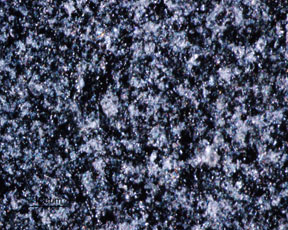 |
Al2O3 |
| Image 7 | Clear glass, two layers, top surface blasted with 120 grit Aluminum Oxide and firepolished at 1450 degrees.
Very few bubbles, nicks and fractures, except at the edge of the piece where there are more. The interface between the two clear layers is not discernable. |
 |
Al2O3a |